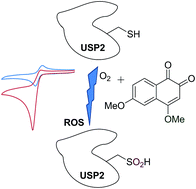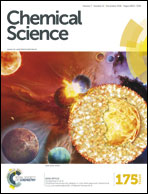Understanding and predicting the potency of ROS-based enzyme inhibitors, exemplified by naphthoquinones and ubiquitin specific protease-2†
Abstract
Recent studies have suggested that selective targeting of overexpressed enzymes in cancer cells by small molecules that induce the formation of reactive oxygen species (ROS) could be a viable approach in cancer therapy. One such example is the inactivation of ubiquitin specific protease-2 (USP2)—an emerging drug target to combat prostate cancer—by β-lapachone, which has been identified to involve oxidation of the catalytic cysteine's thiol residue to sulfinic acid. A rational design of β-lapachone analogs with improved activity requires a much better understanding of the variables that determine ROS production by this class of molecules. This crucial aspect was addressed via modulation of its 1,2-naphthoquinone scaffold and establishment of a structure/activity relationship, regarding its ability to reduce molecular oxygen to a ROS. The same series of compounds was also examined in terms of their inhibitory effect on the enzymatic activity of USP2. One deduction from these investigations was that the ortho-quinone motif in β-lapachone is much better suited for the catalytic reduction of oxygen than the para-quinone motif and some approved quinone based drugs. A broader conclusion, obtained from the series of compounds with ortho-quinone motifs, is that only the agents whose redox potential is in the narrow range of −0.3 ± 0.1 V (vs. Ag/AgCl in pH 7.5 aqueous buffer) induce the formation of ROS. The excellent correlation between the ROS production ability and the USP2 inhibition potency emphasizes that the relatively easy, fast, and reliable testing of electrocatalytic oxygen reduction by small molecules might be applied to screening and evaluating new drug candidates for similar targets.

- This article is part of the themed collection: ISACS19: Challenges in Organic Chemistry

 Please wait while we load your content...
Please wait while we load your content...